FORT CROWN POINTNEW YORK |
 |
FORT CROWN POINTNEW YORK |
 |
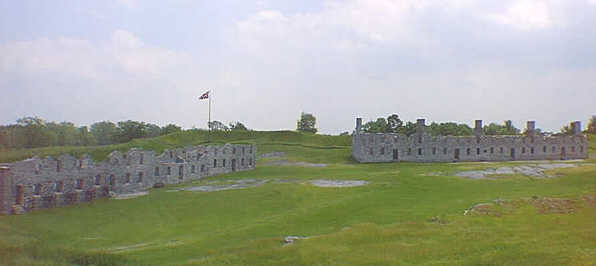
The Visitor Center includes exhibits that interpret the French, British, and American chapters of Crown Point's history. This historic site contains the impressive ruins of Fort Crown Point, including Fort St. Frederick (a fortress within a fort). The site was donated to the State of New York in 1910 and since that time, they have had to initiate several major stabilization efforts to keep the walls from falling down. Northeast winters cause the ground to expand and contract. This constant movement is a major problem for these old forts, including the restored Fort Ticonderoga to the south. You will likely observe collapsing walls supported by large timbers at both locations.
A century before the American Revolution, Crown Point was a vital and well-known area in the long struggle between France and Great Britain for the North American empire. Lake Champlain, a major highway for commerce and military supplies, was a target for control by both nations.
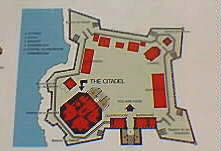 Fort
Crown Point before the American Revolution France, in 1734, began
construction at Crown Point, the first substantial fortification in the
Champlain Valley.
Fort
Crown Point before the American Revolution France, in 1734, began
construction at Crown Point, the first substantial fortification in the
Champlain Valley.
From 1734-1755, Fort St. Frederic at Crown Point gave France complete control of the Champlain Valley. Charles de Beauhamois, Governor of New France (Canada), actively encouraged settlement in the vicinity of Fort St. Frederic through generous royal grants of land, creating a French community around the fort. This combined military and civilian presence thwarted British expansion, and was an annoyance to British authorities. In 1759, the fort was taken by a combined force of British regulars and provincial troops numbering about 12,000 men.
The British immediately began construction of "His Majesty's Fort of Crown Point," as well as three redoubts and a series of blockhouses and redans, all interconnected by a network of roads. The fortification complex covered over three and one-half square miles, making it one of the most ambitious military engineering projects undertaken by the British in colonial North America.
Lake Champlain became a vital highway linking two diverse regions of British North America. Crown Point, located midway between Albany and Montreal, became the center of communication between New York and Canada.
|
|
Crown Point Following the French retreat from Crown Point in 1759, General Amherst embarked upon an ambitions plan to secure the area for Britain. An elaborate system of fortifications was begun on the point. At times, as many as 3000 soldiers and artisans were engaged in the construction of Fort Crown Point, three smaller forts, called redoubts, several block houses, store houses, gardens and military roads. A village grew up close to the Fort wall with a tavern, store, ecothecary shop, and the home of soldiers families and retired officers. When control of Canada passed to Britain, at the end of the French and Indian War in 1763, construction ceased leaving one barracks building unfinished. In April 1773, a chimney fire spread from the soldier's barracks on the log walls of the fort resulting in the explosion of the powder magazine and the virtual destruction of the main fort. Troop strength at Crown Point was gradually reduced until only a tiny garrison remained to surrender the fort to American rebel troops commanded by Seth Warner in May of 1775. |
|
|
|
|
|
Fort Crown Point during the American RevolutionAt the outbreak of the American Revolution, the rebellious colonists looked to Crown Point to aid their cause.
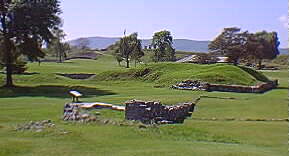 The
surrender of Fort Crown Point to American rebel troops commanded by Seth Warner
in May of 1775 yielded 114 pieces of cannon and heavy ordnance sorely needed by
the Americans. Colonel Henry Knox carried twenty-nine of these to Boston during
that winter to force the British out of the city.
The
surrender of Fort Crown Point to American rebel troops commanded by Seth Warner
in May of 1775 yielded 114 pieces of cannon and heavy ordnance sorely needed by
the Americans. Colonel Henry Knox carried twenty-nine of these to Boston during
that winter to force the British out of the city.
On May 23, 1775, Fort Crown Point was the meeting place for Ethan Allen, the Green Mountain Boys, Benedict Arnold and his small American Navy. Ethan Allen was returning from an attempted penetration of Canada, but was driven out by British troops. A month later, the British would take Allen prisoner in another unsuccessful attempt. Benedict Arnold and his navy would assume control of Crown Point and Lake Champlain. A month later, he would relinquish it to General Philip Schuyler's Northern Department of the Continental Army in a dispute over control.
In the fall of 1775, Schuyler and his army embarked from Crown Point with 1,700 troops for another attempt to conquer Canada. Beaten, they returned from Quebec in June 1776, to lie in makeshift hospitals at Crown Point.
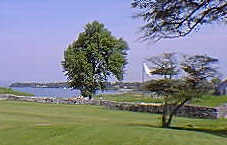 |
In May 1775, Seth Warner's American Forces captured the fort and Crown Point became a springboard for an invasion of Canada. General Richard Montgomery's force sailed down the lake in August 1775. Despite initial success in Montreal, the combined forces of Montgomery and Benedict Arnold were defeated at Quebec in December 1775. They retreated in disarray, riddled with smallpox, to Crown Point. Men died by the hundreds in makeshift field hospitals and were buried in mass graves. |
In the fall of 1776, Lieutenant-Colonel Thomas Hartley and the 6th Pennsylvania Regiment heard the sounds of the naval engagement at Valcour Island from their entrenchments at Crown Point. The American Navy, once again led by Benedict Arnold, ambushed the British Naval Force, but was eventually forced to retreat down Lake Champlain. The regiment at Crown Point also retreated southward to Fort Ticonderoga and Mount Independence.
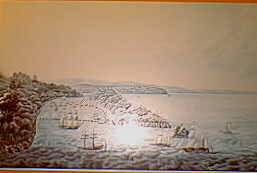 |
While Arnold directed the construction of a Naval Squadron in the summer of 1776. Tripps fortified Crown Point in preparation of an expected British attack. Not until Arnold's squadron was badly beaten at the battle of Valcour Island in October did the last American troops abandon Crown Point to occupy Mount Independence overlooking Fort Ticonderoga. |
Crown Point was a staging area for the British in both 1776 and 1777. After the Americans abandoned Crown Point, the British assembled their troops here. Delayed by the American Navy, Sir Guy Carleton arrived here with his troops in October of 1776, but retreated north for the winter shortly thereafter. British General John Burgoyne's army arrived here in June of 1777. Crown Point remained under British control until the end of the war.
 |
The last major action to involve Crown Point was Burgoyne's expedition in 1777. As support for his advancing army, a hospital was erected, a garrison of 200 men, was left at Crown Point that summer. Despite Burgoyne's defeat at Saratoga, the British retained absolute control of Lake Champlain with the garrison at Crown Point for the remainder of the war. Their ships cruised regularly between Crown Point and the naval shipyard at St. John. Crown Point did not return to American control until after the Peace Treaty, 1783 . |
 |
Chimney Point This strategic point on Lake Champlain was occupied by Native Americans for thousands of years. In 1690 Jacobus deWarm built a small stone fort here. The French built a wooden stockade in 1731, erecting Fort St. Frederic across the lake in 1734. After the 1759 French retreat to Canada, the houses were burned, leaving only the chimneys and the name Chimney Point. The British built a military road in 1759 to connect Fort No. 4 (Charlestown, NH) to their new fort at Crown Point, NY: the road ended two miles to the south. They also built earthworks at Chimney Point, as did American Revolutionary forces in 1776. The tavern, built in the 1780s, was visited in 1791 by Thomas Jefferson and James Madison. In the early 1900s, it was a summer resort. |
